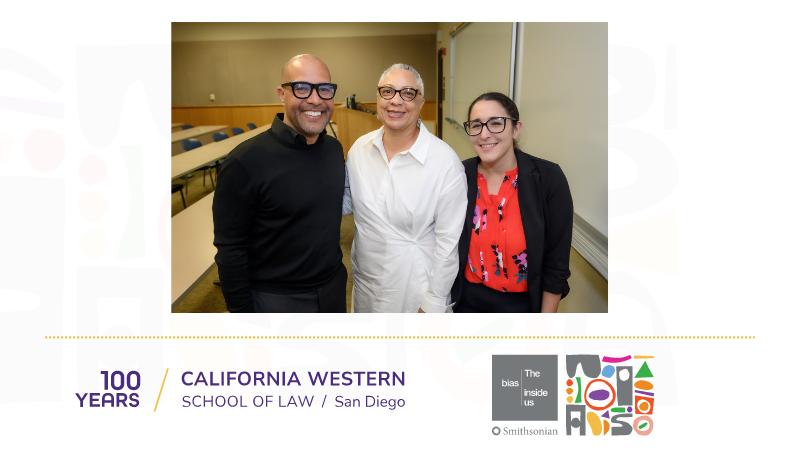
CWSL Hosts George Fatheree for “Critical Conversations: Breaking Barriers to Property Ownership”

SAN DIEGO (May 23, 2024) – “We are educators at our heart. We prepare our students by having difficult conversations like these and sending them out into the world with the skills to do justice.”
That is how California Western School of Law (CWSL) President and Dean Sean Scott summed up the importance of last night’s panel, “Critical Conversations: Breaking Barriers to Property Ownership,” featuring George Fatheree and Professor Emily Behzadi Cárdenas. This event was developed in connection with the Smithsonian Institution’s The Bias Inside Us exhibit, which the school is hosting on campus throughout May. The Bias Inside Us is a community engagement project that explores the science and consequences of implicit bias, giving visitors an opportunity to learn how to become aware of and challenge bias in the world.
Last night’s conversation centered around Bruce’s Beach in Manhattan Beach, California, where, in the 1920’s, the city used a racially motivated claim of eminent domain to evict Willa and Charles Bruce from the beachfront property that they rightfully owned and where they had established a popular resort for African Americans. In great detail, Mr. Fatheree took audience members through the history of the location, the Bruces’ ingenuity in creating a successful business to support themselves and what was becoming a burgeoning Black community, and the deliberate coordinated effort between white community members, a real estate agent, and city council members to dispossess the Bruces under a false notion of eminent domain, claiming that a park needed to be built on that particular plot of land. Mr. Fatheree noted that “to this day, no park has been built at Bruce’s Beach.”
The story does not end there, however. In 2020, a protest was organized at Bruce’s Beach calling for restitution of the land. Janice Hahn, a Los Angeles County Board of Supervisors member, initiated conversations to see how that could be done. Ultimately, Mr. Fatheree, an expert in real estate law, took on the case pro bono, saying to the Bruces’ descendants, “I’ve been preparing my entire life to be of service to your family.” With significant legal maneuvering, including changing legislation and winning a civil lawsuit, Mr. Fatheree and his team were able to return the property to its rightful owners. The LA County Board of Supervisors voted unanimously to that effect on June 28, 2022.
Professor Behzadi Cárdenas, whose scholarship revolves around the convergence of cultural heritage law, human rights, and social justice, asked Mr. Fatheree how this case reflects broader issues of systemic racism in ownership. Mr. Fatheree responded that eminent domain was only “one tool to deprive Black people of opportunities to build generational wealth,” and consequently “we need lots of models of reparations.” Mr. Fatheree’s two latest ventures include his company ORO Impact, which helps companies provide loans to employees looking to become homeowners, and The Black Land Loss Narrative Archive Project, which catalogs stories like the Bruces’, raising awareness about the many ways in which African Americans were dispossessed by legal and extralegal means.
“To think about restitution, you have to think about the magnitude of the loss,” said Mr. Fatheree. He offered a comparison between the Bruces, who opened their resort in 1912, and Conrad Hilton, founder of Hilton Hotels, who also began his business in the early 1910's. Today, Mr. Fatheree said, “Hilton is worth $40 billion, and six Hilton heirs are in the Forbes 400 richest Americans. The Bruces have gotten their land back, but they won’t get a hundred years of building wealth through beachfront property in Manhattan Beach.” Noting the intersections with bias and awareness, Mr. Fatheree commented further that Manhattan Beach today has the lowest Black population of any city in Los Angeles County, “and you can draw a straight line between the eminent domain case and that number. But if you didn’t know that history, you might think, ‘Black people don’t like the beach.’”
Professor Behzadi Cárdenas noted that California appears to be building some momentum in making restitution in cases like these to both Black and Mexican property owners, pointing to the recently introduced Chavez Ravine Accountability Act, which seeks to provide reparations to families that were ousted from the land on which Dodger Stadium was built. She commented that there are often “no legal remedies, so state and local governments need to be interested. Attorneys can be leaders in getting the ball rolling.”
Dean Scott said that is precisely what California Western graduates can do and are being prepared to do. Mr. Fatheree concluded with a message to students, “Be ready when called upon to help.”
The Bias Inside Us is organized by the Smithsonian Institution Traveling Exhibition Service (SITES). Major support is provided by The Otto Bremer Trust. Local support for this event was provided by San Diego Foundation and the Law, Equity, Inclusion, and Diversity (LEID) Fund.
